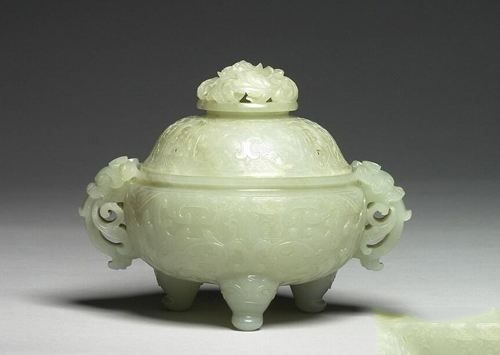The Artistic Value of Jade Articles in the Qing Dynasty
The Qing Dynasty was the last dynasty of China's feudal society. The jade was developed in an unprecedented period during this period, forming another peak in the history of ancient Chinese jade. The jade used in the court of the Qing Dynasty was directly controlled and influenced by the art of painting in the court of the Qing Dynasty. Its workmanship was rigorous and meticulous. Some of them are meticulously crafted, such as carved paintings, and some are used in polishing to show the beauty of the warm and crystal-clear jade. In the Qing Dynasty, heavy white jade, especially the sheep white jade, the topaz was rare, and it was also loved. The folk use of jade is the most and most refined in the two rivers. The most prestigious jade-grown center in the Qing Dynasty was Suzhou's exclusive alleys, Suzhou jade exquisite and charming, and the inner court jade craftsmen also came from this place. Yangzhou jade is developing very fast, and it has a tendency to come up later. Its jade is unrestrained and strong, and it is especially good at crushing a few jade articles of several thousand pounds or even tens of thousands of pounds. The "Dayu Water Control Map of Yushan" is its masterpiece. Yushan was built in the fifty-two years of Emperor Qianlong (1787). The Artistic Value of Jade Articles in the Qing Dynasty There are many varieties and quantities of jade articles in the Qing Dynasty, with the most furnishings and accessories, and the most beautiful. The furnishings are antique wares embroidered with bronze, and there are various animal shapes that symbolize auspiciousness. The newly added varieties include landscapes, flowers and birds, Yushanzi, embossed jade screens and so on. The variety of jade ornaments is very rich. In addition, there are various kinds of practical utensils and stationery for jade. The jade wares of the Qing Dynasty were good at drawing on the achievements of painting, sculpture and arts and crafts. They gathered a variety of traditional workmanships such as Yinxian, Yangxian, Kongkong and Pretty, and the artistic style of the past generations. They created and developed the jade crafts with strong craftsmanship and decoration. It has distinct characteristics of the times and high artistic attainments. There are many large-scale ornamental "Yushan" in the jade articles of the Qing Dynasty. They are based on landscape paintings and are designed and produced on the spot. Its workmanship is rigorous and meticulous. For example, the author uses the white and red of jade, and the clever enamel is made into dense trees, rockeries and stone benches. It is very poetic in the Jiangnan courtyard. Qing Dynasty jade features: In the Qing Dynasty, jade articles formed a peak period in the history of jade articles in terms of the number of varieties and manufacturing processes. Formed "Nanyu" with different styles and technical features, and "Beiyu" made jade center. In the Qing Dynasty, the variety and quantity of jade articles were numerous, and the furnishings and jade ornaments were the most developed. The furnishings include antique wares of bronze ancestors and a variety of beasts and snails. The new varieties include landscapes, flowers and birds, jade mountains, and embossed jade screens. Yupei's variety is more abundant, and it has become an ornament and mascot for all kinds of folk customs and clothing. In addition, a variety of jade utensils with practical functions, the number and variety of stationery supplies have increased more than the past. In the production of jade articles in the Qing Dynasty, the Qianlong era was used as the dividing line. The pre-treatment jade attached importance to the selection of materials. Due to the improvement of mining conditions, the number of high-quality white jade and suet jade collected was higher than any period in history. The exquisite materials provide a material basis for many jewels of art during this period. In terms of process processing, it is exquisitely finished and exquisite in workmanship. The contours of the Jadeware in the Qianlong era were extremely regular, and the horizontal and vertical edges and the sub-ports turned sharply and straight. The edges and corners are more sharp and sharp. The edge of the embossed pattern is also processed into a sharp edge, which is transparent and touches the hand. It is also very particular about the polishing process. Generally, the traces of enamel are not visible in the fine light, and the fine light can reach the brightness of the glass. After the middle period of the Qing Dynasty, the production of jade articles gradually declined, not only the scale was reduced, but the specifications on the craftsmanship made the work more and more rough. If the trees and flowers are stalked, the rounded, ecologically-friendly image is no longer refined, and only the angled projections on both sides are replaced. The floral pattern is no longer meticulously scribbled by the branches and leaves, and the leaves are rolled over, and too many flat bas-relief treatments are taken. In particular, the contours of the vessels are mostly muddy and watery, and the transition is ambiguous. Many of the jade furnishings, jade people, Yushan, and even the small pieces of jade and jade are also used for rough processing. Velvet Knitted Fabric,Light Red Velvet Fabric,Dark Green Fabric,100T Polar Fleece Shaoxing Weihui International Trade Co.,Ltd. , https://www.weihui-fabrics.com
